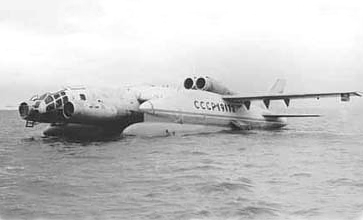✈️ Bartini Beriev VVA-14 — Review
🧩 Overview
The Bartini Beriev VVA-14 is one of the most unusual aircraft ever conceived — part flying boat, part hovercraft, part anti-submarine patrol aircraft, and part Ekranoplan (wing-in-ground effect vehicle). Designed in the early 1970s by Italian-born Soviet engineer Robert Bartini, the VVA-14 was intended to take off vertically, fly at high subsonic speeds, and cruise just meters above the sea to evade detection.
Its mission? Hunt and destroy U.S. nuclear submarines using advanced sensors and long-range torpedoes — all while operating off both land and water without needing runways.
⚙️ Specifications
-
First flight: 1972
-
Total built: 1 prototype (partially completed)
-
Length: 28.5 m (93.5 ft)
-
Wingspan: 30 m (98.4 ft)
-
Max speed: ~760 km/h (472 mph)
-
Range: ~2,500 km
-
Engines:
-
2 × main cruise turbofan engines
-
12 × vertical lift jet engines (never fully installed)
-
-
Crew: 2–3
-
Takeoff: Originally designed for VTOL, but flew only with conventional takeoff
🛠 Design & Capabilities
-
Amphibious hull: Shaped for smooth water landings and takeoffs
-
Ground effect wings: Short, stubby wings designed for stable high-speed flight just meters above the water
-
Lift jets: 12 small engines were meant to provide vertical lift, but these were never fully integrated or tested
-
Anti-submarine gear: Planned to include magnetic anomaly detectors (MAD), sonar buoys, torpedoes — all aimed at U.S. SSBNs (ballistic missile submarines)
Its twin roles — flying as a plane or skimming like an Ekranoplan — made it conceptually versatile, but technically extremely complex.
📜 Development History
-
The project was approved in 1965, with the prototype completed by 1972
-
Initial flight tests were done without VTOL engines, so it operated like a normal plane
-
In 1974, Robert Bartini died, and with him, much of the drive behind the project
-
The program struggled with engine issues, funding, and technical feasibility
-
It was ultimately canceled, and the only airframe now sits in a museum in Monino, Russia, in deteriorated condition
🧱 Strengths
-
Incredibly innovative — decades ahead of its time in many ways
-
Multi-environment operation: land, water, air, ground effect
-
Stealthy concept: Flying low over water would’ve made it hard to detect by radar
-
Would have given the USSR a unique anti-submarine tool
⚠️ Weaknesses
-
Too complex: Vertical takeoff and ground-effect flight are both extremely hard to combine
-
Never fully equipped with all engines or mission systems
-
Heavy and inefficient when not using ground effect
-
Died with its visionary creator — the Soviet military never fully backed it
🏁 Final Verdict:
| Category | Rating (★ out of 5) |
|---|---|
| Innovation | ★★★★★ |
| Feasibility | ★★☆☆☆ |
| Performance (planned) | ★★★☆☆ |
| Legacy | ★★★★☆ |
| Weird/Cool Factor | ★★★★★ |

Comments are closed